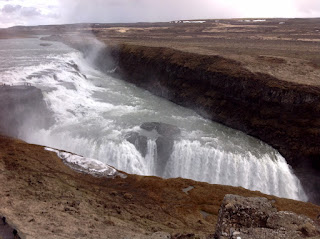 |
| Pilot arrives to guide us into port |
 The
Vestmannaeyjar archipelago (the Westman Islands) lies off the south west coast
of mainland Iceland. Heimaey, the largest island in the group, is the
only inhabited one. Originally settled
by escaped Irish slaves in 900 AD the islands suffered through hardships and piracy during its long history.
The
Vestmannaeyjar archipelago (the Westman Islands) lies off the south west coast
of mainland Iceland. Heimaey, the largest island in the group, is the
only inhabited one. Originally settled
by escaped Irish slaves in 900 AD the islands suffered through hardships and piracy during its long history.  |
| A long way to go for milk! |
 In spite of it all, Heimaey evolved into an important part of the Icelandic fishing industry
because of its strategic harbour and proximity to the fishing grounds.
In spite of it all, Heimaey evolved into an important part of the Icelandic fishing industry
because of its strategic harbour and proximity to the fishing grounds. Ocean Diamond’s sail into Heimaey was nothing short of amazing. A protected harbour set amongst steep volcanic outcrops, the secluded port was not immediately visible from the sea. As we manoeuvred around each dramatic rocky protrusion, the town and its harbour eventually came into view. For the ship’s crew it was a fine display of seamanship navigating to the dock.
It was the events of January 1973 that have created a new landscape in this part of the world. Without any warning a large fissure angrily split the earth open disgorging molten lava. The
town’s 5,000 inhabitants were evacuated but two days later a large cinder cone
erupted from the fissure. While close to
800 homes were destroyed Heimaey had gained a new volcano that was subsequently
named Eldfell (Fire Mountain). The
eruption lasted over five months.
 |
| Lava Flow frozen in time |
A pumping ship arrived spraying 100 gallons of seawater per second. With the help of more powerful pumps over six million tons of seawater was pumped onto the lava in efforts to halt the encroaching lava flow.
The harbour was saved as well as part of the town but almost 50 years later the drama of that time is front and centre. Had that eruption closed off the harbour it would have brought disaster to the fishing industry, the main activity of the town.
 |
| Volcanic landscape popular with hikers |
Visiting the weather research facility high on the island, the view of the volcanic landscape and an 18 hole golf course set in part of a
crater was a pretty dramatic setting. Icelanders love their golf!
 |
| Pristine greens - spot the elephant trunks in the rock face |
Despite the previous day's stellar display of seamanship, our arrival into the port of Reykjavik the next morning went awry. The starboard side of the ship scraped hard against the breakwater. Hopefully just a paint job.
But what grist for Tatyana’s mill as she prepares for her next group of passengers!
That’s the thing about Iceland, land of ice and fire. It’s full of surprises on all sorts of levels.





































